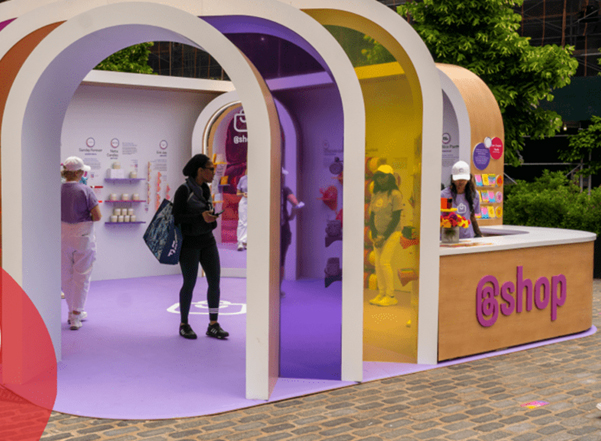To Experience the Future of Retail, You’ll Want to Go to the Store

By Viral Shah, frog, part of Capgemini Invent.

Over the past three years, most of us have done a lot more shopping online, so it’s easy to forget that while ecommerce is still growing, most retail commerce still happens in stores. In Q3 2022, ecommerce accounted for less than 15% of all retail sales. That means brick-and-mortar is still going strong, and not just because consumers are eager to get out of the house again.
Shoppers now view stores as places to check out items before buying, to get purchasing advice, to have relaxing or exciting experiences, to meet like-minded people and to put their sustainability principles into practice. Retailers can meet these expectations by providing the experiences their customers want. Here are six ways we see retailers innovating the in-store experience to keep up.
1. Create a showroom experience with expertise.
Most customers prefer to see a product in person before they make a buying decision, especially if the product is expensive, technical, or has multiple options. Forrester and Shopify found that more than half (54.5%) of holiday 2022 shoppers planned to visit brick-and-mortar stores for this reason. A positive experience in the store can lead to a purchase during the visit or online after the visit, while an underwhelming experience represents a missed opportunity.
Retailers can capitalize on customers’ desire to see products in person by turning physical stores into showroom experiences that offer expert guidance from employees on choosing and configuring products. One major phone and computer manufacturer delivers perhaps the best example of this type of showroom experience, with experts on hand to guide customers through purchases and tech issues. A flat-pack furniture retailer’s maze-like store layout shows customers how their products work in different settings and gives them the chance to touch and try out items.
2. Offer a playground for immersive experimentation.
Trying out new products and discovering new ways to use familiar ones can help customers build loyalty to a brand. In-store experimentation experiences are opportunities to entertain, energize and inspire customers while connecting emotionally with them. This is especially important for connecting with Gen Z customers, two-thirds of whom like to shop in-store when they’re looking for new products.
A sporting goods retail chain has three specialized locations that are almost literal playgrounds, each with an indoor track and field, climbing wall, batting cage and other spaces where athletes and weekend warriors can learn about and try out new equipment. One of the leading cosmetics and personal care retailers, meanwhile, describes its stores as “beauty’s playground,” where customers can discover exclusive independent brands, get beauty treatments and attend classes on skincare and other beauty routines. These kinds of experiences can strengthen customers’ emotional connection to the brand.
3. Welcome your brand community in a clubhouse space.
For retailers that have a community of customers centered on their brand, creating in-store community spaces can increase traffic, strengthen customer loyalty and attract new customers who are seeking communities aligned with their interests. These spaces can be permanent in-store features or they can be pop-ups in stores and in other locations where customers spend time.
For example, an electric truck maker’s main location features a maker space, library, courtyard and store. Customers can learn about the brand’s vehicles, but they can also connect over other shared “green” interests like camping, gardening and adventure travel. Customers are encouraged to bring friends, which can help grow the brand’s fan base organically.
4. Set up space for customers to relax.
While some consumers crave a connection to a large and active community, others seek out spaces where they’re welcomed with a calming experience. Retailers with products that align with wellness and hospitality are in an especially good position to create an in-store “oasis” where customers can de-stress and enjoy the ambiance. When these consumers feel catered to, it creates more loyalty.
Luxury retailers are an especially good fit for the oasis experience. For example, one upscale home goods retailer’s innovative guesthouse in New York City is designed to “erase the chaos of the outside world” for restaurant and overnight guests. The brand also opened a combination showroom and restaurant in San Francisco in early 2022, and recently purchased a Napa Valley resort, possibly to expand on their showroom-as-oasis-experience strategy.
5. Provide space for customers to create.
70% of consumers say “it’s important for brands to provide them with personalized experiences,” and letting customers customize their own products in-store can be an exciting way to do that. An added benefit of adding “studio space” to a store is the potential for more user-generated content (UGC) about the brand. One study found that UGC has 8.7X as much impact as content by influencers and 6.6X more impact than branded content.
One digital beauty brand built its Los Angeles flagship store with customer creativity and content generation in mind. Architectural Digest notes that the interior décor is “ready-made for an Instagram close-up,” including plenty of open floor space for post-makeover group selfies. Even the mirrors are lit for optimal selfie results. A leading sports apparel brand goes a creative step further with a space inside its New York innovation flagship location. There, customers are invited to customize existing shoe models or design their own shoes for production and purchase.
6. Build a “garden” for product repair or recycling.
Giving customers sustainable in-store options for repairing and recycling products nurtures loyalty. An Economist/World Wildlife Fund survey found that 65% of consumers believe brands are as responsible as governments for promoting positive social change. One way to do that is to create a space for product renewal and reclamation. A major electronics retailer has become a destination for customers who want to recycle old televisions, phones, ink cartridges, appliances and other items. By offering gift cards for recyclable trade-ins, the chain drives in-store traffic and builds sustainability credibility with consumers.
Creating New Value with In-Store Experiences
Each of the approaches discussed above leverages store space to offer customers an experience they can’t get online, which can encourage them to keep coming back. These experiences aren’t mutually exclusive, either. For example, an upscale department store chain shows how it’s possible to blend an oasis, a garden and a showroom by offering spa services, tailoring and in-store stylist services. Every retailer can develop a unique in-store experience based on what its customers want, what the retail space can accommodate and what will showcase products and services in the best way to cultivate loyalty and encourage revenue growth.
Viral Shah is VP and Head of Strategy at frog San Francisco, part of Capgemini Invent. Shah focuses on helping clients define and achieve their business objectives while pioneering innovative products and services for their customers.
DESIGN YOUR FUTURE TODAY!
Interior Designers Institute was founded in 1984 and is one of the few Interior Design Schools in California offering an Avocational Certificate Course, Associate of Arts Degree in Interior Design, Bachelor of Arts Degree in Interior Design, and Master of Interior Architecture Degree and is nationally accredited and also accredited by CIDA, Council for Interior Design Accreditation.

